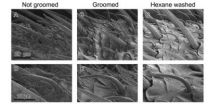(Press-News.org) Like a self-absorbed teenager, insects spend a lot of time grooming.
In a study that delves into the mechanisms behind this common function, North Carolina State University researchers show that insect grooming – specifically, antennal cleaning – removes both environmental pollutants and chemicals produced by the insects themselves.
The findings, published online this week in Proceedings of the National Academy of Sciences, show that grooming helps insects maintain acute olfactory senses that are responsible for a host of functions, including finding food, sensing danger and even locating a suitable mate.
The findings could also explain why certain types of insecticides work more effectively than others.
Insects groom themselves incessantly, so NC State entomologist Coby Schal and post-doctoral researchers Katalin Boroczky and Ayako Wada-Katsumata wanted to explore the functions of this behavior.
They devised a simple set of experiments to figure out what sort of material insects were cleaning off their antennae, where this material was coming from, and the differences between how groomed and ungroomed antennae functioned. Schal likened the straightforwardness of some of the experiments to something you'd see in a well-equipped high-school science lab.
The researchers compared cleaned antennae of American cockroaches with antennae that were experimentally prevented from being cleaned. They found that grooming cleaned microscopic pores on the antennae that serve as conduits through which chemicals travel to reach sensory receptors for olfaction. Cockroaches clean their antennae by using forelegs to place the antennae in their mouths; they then methodically clean every segment of the antenna from base to tip.
The researchers found that both volatile and non-volatile chemicals accumulated on the ungroomed antennae of cockroaches, but most surprising was the accumulation of a great deal of cuticular hydrocarbons – fatty, candlewax-like substances secreted by the roaches to protect them against water loss.
"It is intuitive that insects remove foreign substances from their antennae, but it's not necessarily intuitive that they groom to remove their 'own' substances," Schal says.
The researchers also tested groomed and ungroomed cockroach antennae to gauge how well roaches picked up the scent of a known sex pheromone compound, as well as other odorants. Clean antennae responded to these signals much more readily than ungroomed antennae.
The researchers then put carpenter ants, houseflies and German cockroaches to many of the same tests. Although they groom a bit differently than cockroaches – flies and ants seem to rub their legs over their antennae to remove particulates, with ants then ingesting the material off their legs – the tests showed that these insects also accumulated more cuticular hydrocarbons when antennae went ungroomed.
"The evidence is strong: Grooming is necessary to keep these foreign and native substances at a particular level," Schal says. "Leaving antennae dirty essentially blinds insects to their environment."
Schal adds that there could be pest-control implications to the findings. An insecticide mist or dust that settles on a cockroach's antennae, for instance, should be ingested by the roach rather quickly due to constant grooming. That method of insecticide delivery could be more effective than relying on residual insecticides to penetrate the thick cuticle, for instance.
Finally, Schal says the study can also be used as a caution to other researchers who use insects in experiments. Gluing shut an insect's mouth to prevent it from feeding, for example, also prevents the insect from grooming its antennae. Experimental results could be skewed as a result of this sensory deprivation, Schal suggests.
INFORMATION:
Dale Batchelor, a researcher in NC State's Analytical Instrumentation Facility, co-authored the paper, as did Marianna Zhukovskaya at the Russian Academy of Sciences. The research was supported by the National Institute of Food and Agriculture, the U.S. Department of Agriculture, the National Science Foundation and the Blanton J. Whitmire Endowment at NC State.
- kulikowski -
Note to editors: An abstract of the paper follows.
"Insects groom their antennae to enhance olfactory acuity"
Authors: Katalin Boroczky, Ayako Wada-Katsumata, Dale Batchelor and Coby Schal, North Carolina State University; Marianna Zhukovskaya, Russian Academy of Sciences
Published: Online the week of Feb. 4, 2013, in Proceedings of the National Academy of Sciences
Abstract:
Grooming, a common behavior in animals, serves the important function of removing foreign materials from body surfaces. When antennal grooming was prevented in the American cockroach, Periplaneta americana, field emission gun scanning electron microscopy images revealed that an unstructured substance accumulated on nongroomed antennae, covering sensillar pores, but not on groomed antennae of the same individuals. Gas chromatography analysis of antennal extracts showed that over a 24-h period nongroomed antennae accumulated three to four times more cuticular hydrocarbons than groomed antennae. Moreover, nongroomed antennae accumulated significantly more environmental contaminants from surfaces (stearic acid) and from air (geranyl acetate) than groomed antennae. We hypothesized that the accumulation of excess native cuticular hydrocarbons on the antennae would impair olfactory reception. Electroantennogram experiments and single-sensillum recordings supported this hypothesis: antennae that were prevented from being groomed were significantly less responsive than groomed antennae to the sex pheromone component periplanone-B, as well as to the general odorants geranyl acetate and hexanol. We therefore conclude that antennal grooming removes excess native cuticular lipids and foreign chemicals that physically and/or chemically interfere with olfaction, and thus maintains the olfactory acuity of the antennae. Similar experimental manipulations of the German cockroach (Blattella germanica), carpenter ant (Camponotus pennsylvanicus), and the housefly (Musca domestica), which use different modes of antennal grooming, support the hypothesis that antennal grooming serves a similar function in a wide range of insect taxa.
Grooming helps insects keep their senses sharpened
2013-02-05
ELSE PRESS RELEASES FROM THIS DATE:
Antibody hinders growth of Gleevec-resistant gastrointestinal tumors in lab tests
2013-02-05
STANFORD, Calif. - An antibody that binds to a molecule on the surface of a rare but deadly tumor of the gastrointestinal tract inhibits the growth of the cancer cells in mice, according to researchers at the Stanford University School of Medicine.
The effect remains even when the cancer cells have become resistant to other treatments, and the findings may one day provide a glimmer of hope for people with the cancer, known as gastrointestinal stromal tumor, or GIST. The scientists hope to move into human clinical trials of the antibody within two years.
The antibody's ...
USC scientists design mouse with more human-like immune response
2013-02-05
LOS ANGELES — Medical scientists at the University of Southern California (USC) have bred a first-of-its-kind mouse model that possesses an immune response system more like a human's. The discovery makes way for quicker and more cost-effective development of next-generation drugs to treat human diseases like cancer, diabetes and tuberculosis.
Medical researchers have long used mice and rats to help formulate new drugs and vaccines, in part because their genetic and biological characteristics closely parallel human physiology. But mice are not humans, and many experimental ...
Cells predict onset of graft-versus-host disease in men receiving BMTs from female donors
2013-02-05
STANFORD, Calif. — Stanford University School of Medicine investigators have identified a clutch of cells that — if seen in a male patient's blood after receiving a brand-new immune system in the form of a bone-marrow transplant from a female donor — herald the onset of chronic graft-versus-host disease, or cGVHD. In this devastating syndrome, the patient's tissues come under a vicious and enduring assault by the transplanted cells.
"The overwhelming majority of patients who have these cells in their blood either have or will develop cGVHD within one to three months," ...
3D printing breakthrough with human embryonic stem cells
2013-02-05
A team of researchers from Scotland has used a novel 3D printing technique to arrange human embryonic stem cells (hESCs) for the very first time.
It is hoped that this breakthrough, which has been published today, 5 February, in the journal Biofabrication, will allow three-dimensional tissues and structures to be created using hESCs, which could, amongst other things, speed up and improve the process of drug testing.
In the field of biofabrication, great advances have been made in recent years towards fabricating three-dimensional tissues and organs by combining artificial ...
'Default' options influence patient choices in advance care directives, Penn study shows
2013-02-05
PHILADELPHIA – Advance care directives allow patients to provide instructions about their preferences for the care they would like to receive if they develop an illness or a life-threatening injury and lose the capacity to make decisions for themselves. While many people may assume that patients have strong preferences for the type and aggressiveness of care they wish to receive near life's end, a new study by researchers at the Perelman School of Medicine at the University of Pennsylvania suggests that for many patients, preferences for end-of-life care are constructed ...
Experimental therapy crosses blood-brain barrier to treat neurological disease
2013-02-05
CINCINNATI – Researchers have overcome a major challenge to treating brain diseases by engineering an experimental molecular therapy that crosses the blood-brain barrier to reverse neurological lysosomal storage disease in mice.
Posted online in PNAS Early Edition on Feb. 4, the study was led by scientists at Cincinnati Children's Hospital Medical Center.
"This study provides a non-invasive procedure that targets the blood-brain barrier and delivers large-molecule therapeutic agents to treat neurological lysosomal storage disorders," said Dao Pan, PhD, principal investigator ...
Body language can predict outcomes for recovering alcoholics
2013-02-05
To predict whether a problem drinker will hit the bottle again, ignore what they say and watch their body language for displays of shame, a University of British Columbia study finds.
The study, which explored drinking and health outcomes in newly sober recovering alcoholics, is the first to show that physical manifestations of shame – from slumped shoulders to narrow chests – can directly predict a relapse in people who struggle with substances.
"Our study finds that how much shame people display can strongly predict not only whether they will go on to relapse, but ...
20 hours of TV a week almost halves sperm count
2013-02-05
Healthy young men who watch TV for more than 20 hours a week have almost half the sperm count of men who watch very little TV, indicates a study published online in the British Journal of Sports Medicine.
Conversely, men who do 15 or more hours of moderate to vigorous exercise every week have sperm counts that are 73% higher than those who exercise little, the findings show.
Semen quality seems to have deteriorated over the past few decades, although it's not clear why, say the authors.
To find out if an increasingly sedentary lifestyle might be a contributory ...
The last Neanderthals of southern Iberia did not coexist with modern humans
2013-02-05
The theory that the last Neanderthals –Homo neanderthalensis– persisted in southern Iberia at the same time that modern humans –Homo sapiens– advanced in the northern part of the peninsula, has been widely accepted by the scientific community during the last twenty years. An international study, in which researchers of the Spanish National Distance Education University (UNED) participate, questions this hypothesis.
"It is improbable that the last Neanderthals of central and southern Iberia would have persisted until such a late date, approximately 30,000 years ago, as ...
Mutations in ASXL3 cause problems similar to Bohring-Opitz syndrome
2013-02-05
Mutations which affect the gene ASXL3 cause a novel syndrome similar to Bohring-Opitz syndrome, finds a study published in BioMed Central's open access journal Genome Medicine. This molecular definition distinguishes these children from those with Bohring-Opitz, and other similar syndromes, and highlights a technique able to help define rare diseases.
When Dr Ropers from the Max-Planck Institute for Molecular Genetics in Berlin found a child with non-specific symptoms, including small size at birth, difficulties with movement and feeding, severe intellectual disability, ...

